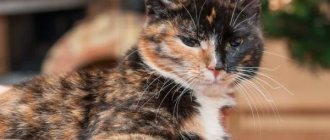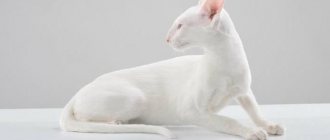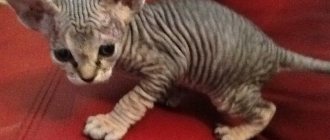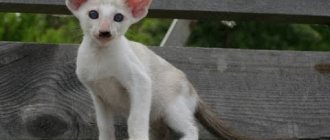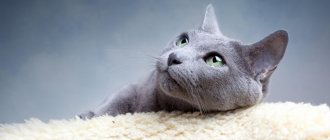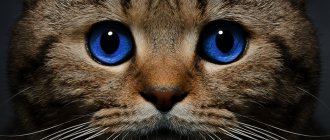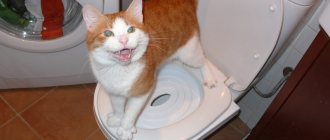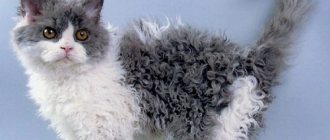There are more of us and we are striped
Outbred cats make up 90% of the entire cat population of the planet. And no other breed can boast of such a variety of coat colors, body dimensions and characters as these felines have. The history of coexistence between humans and cats goes back almost 10 thousand years. In that distant time, cats were not divided into breeds. People were more interested in the practical benefits of pets. They have always been valued as excellent hunters of small rodent pests.
Outbred domestic cats are the best mouse hunters
At different times, attitudes towards cats were ambiguous. The ancient Egyptians deified these animals, and in medieval Europe they were credited with a connection with evil spirits. Domestic or yard cats, descended from wild ancestors, were common on all continents. Differences in climate and nutrition led to a variety of characters and appearance. Some modern breeds, in the formation of which man did not participate, can be considered yard (Siberian and Siamese cats, Angoras and Persians).
Different conditions - different appearance
The diversity of yard cats is explained by their non-standard genotype. It is impossible to guess, let alone calculate what kind of offspring an outbred cat will produce. The mixing of many breeds, and therefore hereditary characteristics, leads to the fact that yard kittens are born with a variety of coat colors and body sizes. Different eye colors, length and shape of tail and ears. The most common color of outbred murki is brindle or spotted. It allows you to camouflage in “field conditions”. A white barn cat is very rare. Individuals with long hair are also rare. Almost all representatives of the yard cat fraternity are short-haired. Medium size. Weight does not exceed 6 kilograms. Conventionally, mongrels are divided into two types according to the climatic conditions in which the breed was formed: northern and southern. The former have a dense, massive constitution and long, thick hair. Southerners are more graceful, with a thin skeleton and short hair without a pronounced undercoat.
The most common coloring of wild cats is stripes on a light background.
Angelic character of a wild beast
Where yard cats have a clear advantage over purebred cats is in their character traits and attitude towards their owners. By adopting a mongrel kitten, you can be sure that a creature has settled in the house who will be grateful to you all its life.
Outbred cats are restrained in showing emotions. It is as difficult to predict a pet's character as it is to predict its appearance. Some can be curious and restless. Others behave like born aristocrats, showing honor by the very fact of their existence.
Wild street cats are real predators
A kitten brought into the house, especially if it was born on the street, may be shy and wild at first. From birth, his mother cat taught him to be afraid of people. Only love and patience will help here. The animal will treat the person who will feed and care for the kitten as a kind deity. A mongrel pet treats all family members equally, but chooses its owner, distinguishing him from others.
A barn cat may not be very sociable. Self-sufficiency is one of the main traits of a cat's character. Anger, aggressiveness and touchiness are extremely rare in a purebred cat. Like all cats, tabby mongrels love to play. Having become accustomed to the company of people and having become attached to them, it is difficult to endure long-term loneliness. Up to mental disorders. Try not to let this happen. In addition, cats can be very vindictive and vindictive. For lack of attention or offense they may damage furniture or use their favorite shoes as a toilet.
A little cat history
Cats have been with humans for more than 9,000 years, as evidenced by archaeological research and ancient writings. And in those days, no one thought about whether a cat belonged to a particular breed. In Ancient Egypt, cats were revered as sacred animals and were also valued as excellent rodent hunters. In the Middle Ages, in some countries they were credited with magical properties and connections with evil spirits, in others they were considered special creatures that were a symbol of goodness and peace in the home.
The history of the mustachioed tabby is very rich, but it takes on new colors when cats began to be seriously bred, endowing them with special characteristics.
Since the end of the 19th century, active breeding work has been carried out, which gives birth to more and more new breeds of cats. This produces extraordinary mustaches with varying lengths of fur or even hairless ones, with amazing colors and interesting character traits. Each representative that is recognized by a felinological organization is unique and finds its fans. But with all the variety of purebred purrs, yard cats remain the most numerous and popular.
Making a new friend
The undoubted advantage of outbred cats is that no costs are required to purchase them. Usually such pets are acquired through friends or through an advertisement. Often, stray kittens are picked up on the street. If an animal is taken from home and there is a choice, in order not to make a mistake with the character and health of the kitten, you need to take a closer look at the following signs:
- the kitten readily approaches you, tries to flirt and does not try to show aggressiveness;
- the kitten is distinguished by its external attractiveness, meekness, agility, playfulness, playfulness and does not look sad, dejected or apathetic;
- holds his head up normally and walks or runs with absolutely no limp;
- does not twitch his head, does not have a runny nose, cough, or other external painful signs;
- the kitten's skin looks clean and healthy, without irritation, dirt, scabs or flea excrement;
- the animal's coat is shiny and clean, without bald spots or tangles (matted);
- no liquid or other discharge from the eyes, nose and ears;
- the third eyelid (the so-called nictitating membrane) does not cover part of the eye;
- teeth look clean and free of tartar, there is no unpleasant odor from the mouth;
- The gums of a healthy kitten are pink and there are no signs of bleeding;
- the stomach feels quite strong and at the same time not bloated;
- the anus is clean, without remains of feces, there are no visible signs of diarrhea or worm segments (they, if present, come out of the anus and look like grains of rice).
It is recommended to wean a kitten from its mother no earlier than 2.5–3 months. At this age, the baby will tolerate separation without consequences for the psyche. He is already accustomed to the tray and “adult” food.
Cats are considered social animals. Therefore, experienced felinologists recommend, if possible, purchasing two kittens at once. For the company. Especially if the owners have to be away from home for a long time.
The offspring of outbred cats can be of a wide variety of colors
Where to find a mongrel kitten
Despite the apparent simplicity and obviousness of the answer to the question of how to acquire a simple domus, there may be several options for getting a kitten without a breed into your home:
- It is clear that the easiest and also free method would be to pick up a purr right on the street - in this case, you need to immediately take the animal to a veterinary clinic for examination;
- for thrifty animal lovers, there is also the option of viewing advertisements about transferring the offspring of a domestic cat “into good hands” for free or for a nominal fee;
You can often purchase outbred kittens through an advertisement “in good hands”
- and those who are looking for a pet with an unusual and noble appearance can turn to nurseries of purebred animals, because cull animals are often born there - such babies are sold several times cheaper than their relatives that meet the standards, which greatly pleases potential owners, especially from those taken from professional clubs kittens already have the necessary vaccinations and even a pedigree.
And although purrs of semi-noble origin will not be allowed to show for their respective breeds, this should not upset furry owners. After all, felinologists came up with special competitions for domestic cats, which are held according to strict rules. At such competitions, the appearance and behavior of the cats are assessed. Animals must be well-groomed and non-aggressive. In this case, defects in appearance (six-fingered, for example) and injuries (scars, broken tail) are allowed.
Important points that you should pay attention to when choosing a kitten you like from a private person or in a nursery:
- the cat should be cheerful and inquisitive, not get scared and not attack;
- the baby’s fur should be clean and fluffy, without tufts or bald spots;
- The seller must keep the ears, nose and eyes of the animal clean;
- the purr's tummy cannot be too swollen, this means that the furry has worms;
- There should be no unpleasant odor coming from the pet’s mouth, indicating diseases of the teeth and digestive tract.
The best age to purchase a mongrel kitten from your own hands or from breeders is considered to be 2.5–3 months of age. At this time, the baby begins to wean off mother's milk and socialize. Therefore, getting into a new family will be accepted by the fluffy without unnecessary stress and deterioration in health.
Video: how to choose the right kitten
Maintenance and care
In keeping, outbred cats are very unpretentious. They are practically omnivores and there are no problems with feeding. It is important that the diet is balanced. You can feed your cat dry or canned industrial food, which already contains all the necessary microelements. Or choose natural food. In this case, the menu is compiled individually based on the preferences and needs of the pet. The cat's diet should include meat and offal (liver, lungs, heart), vegetables and grains (oats, wheat, barley), and dairy products. Use mineral and vitamin supplements if necessary. Remember that food from your table will not replace your pet’s proper nutrition.
The cat's food should be tasty, the bowl should be clean and the water should be fresh.
Your cat should always have access to clean water. Interestingly, cats are more likely to drink if food and water are in different places.
Up to six months, a kitten needs to be fed at least 4 times a day. At 6 months, switch to 2 meals a day. If your pet does not suffer from greed and is not prone to obesity, you can practice free feeding. It is necessary to ensure that the bowl is clean and the food is fresh.
Cleanliness is the key to cat health
Caring for the appearance of a mongrel pet will not cause much trouble. The coat should be combed 1-2 times a week with a stiff brush to remove dead hair. During molting - 2-3 times. To avoid ear mites, wipe your ears with a cloth moistened with hydrogen peroxide. Use special ear drops. Remove discharge from the eyes with a soft cloth. Train your kitten to use a scratching post. This will save you and your cat from the unpleasant procedure of trimming its claws. You need to bathe your pet as soon as it gets dirty. But not often. Cats take care of their fur coats themselves. Almost everyone, with rare exceptions, does not like water procedures.
A good toilet for your beloved cat
When choosing a toilet for a kitten, focus on an adult cat, so as not to buy a new one when it grows up. The pet must enter it entirely. The height of the sides is not lower than 6 cm. It is better to use clumping filler for the tray. It absorbs odor well and simplifies the cleaning process. If finances allow, then the best option would be a box (dry toilet) with replaceable cassettes.
Light and air
Outdoor cats need fresh air and sunlight. Ultraviolet light promotes the production of vitamin B. If your pet constantly lives in an apartment, surprise him - in good weather, take him for a walk in the nearest park or forest. Use a harness with a leash for this. Avoid asphalt. For delicate cat paws, soft soil or grass is better. Try to avoid crowded areas of cars, people and dog walking so as not to scare your pet.
Appearance Features
The aristocratic origin of the graceful representatives of the breed is noticeable even in the look - intelligent and attentive. And the same can be said about other appearance features.
Burmilla has a sophisticated appearance
Burmillas are distinguished by an elegant, medium-sized body that ends in a long, thin tail. The weight of animals does not exceed 5–8 kg and does not depend on gender. The height at the withers of an adult pet ranges from 26–34 cm.
The breed standard also provides for other distinctive features of Burmillas:
- the head is gently rounded at the top and ends at the bottom with a wide, strong chin;
- protruding cheeks are very noticeable in cats, but in cats they have smoother outlines;
- the ears are spaced far apart and tilted forward;
- eyes wide open, almond-shaped;
- a dark line is drawn around the eye sockets, nose and lips;
- the nose is wide, has a clear bend at the base;
- iris color - amber, green or tortoiseshell;
- the limbs are spindle-shaped and have strong muscles.
The fur coat of purebred handsome dogs deserves special attention. At first glance, it seems that the white cat is covered with a thin transparent veil of black or brown color. It's all about the way the pigment is distributed in the villi. In Burmilla, based on this, two types of color are distinguished - tipped, when the hairs are 1/8 dark, and shaded. In the latter case, the hairs are darkened by 2/3 or 4/5 of the part. There is also a brindle variety of color and a solid one, when the fur coat has a uniform tint.
The range of colors among Burmillas is quite diverse and includes the following colors:
- brown;
- lilac;
- tortoiseshell;
- Bombay;
- brindle;
- chocolate;
- cream;
- speckled blue;
- speckled black;
- smoky.
A distinctive feature of the breed is the pure white coloring of the internal parts of the body - the chest, belly, chin, as well as the back of the paws and tail. At the same time, a dark woolen tubercle should protrude on the back of the neck.
Photo gallery: varieties of colors in Burmilla cats
Chocolate Burmilla cats resemble their ancestors, the Burmese cats.
The tortoiseshell color of the Burmilla is the most exotic of all.
The Burmilla's cream-colored coat is a very charming sight.
The speckled black color looks mysterious and unusual
The smoky coat color is characteristic of many representatives of the Burmilla breed.
The mottled blue Burmilla is a very popular cat breed.
If an animal is purchased not only as a simple pet, but also for participation in exhibitions, you need to become familiar with the defects of the breed. After all, shortcomings that appear during the breeding process do not allow winning prizes, and sometimes become the reason for refusal to register for competitions.
The disadvantages of the breed include:
- weakened lower jaw;
- uneven typing;
- brown or yellow shades on the coat;
- the appearance of tabby stripes in the presence of tipping or in a solid color.
The following are recognized as disqualifying characteristics for Burmilla:
- incorrect coloration of the iris in adults (after two years);
- oriental or cobby build (stocky, dense);
- tousled coat with elongated undercoat.
Video: Burmilla cat Max
Not without its drawbacks
If you pick up a mongrel kitten on the street, you risk bringing a sick animal into your home. Be sure to take him to the vet right away. A little street child may have lichen or fleas. It may be infected with an infection or worms. If a purebred parent took part in the birth of a kitten, then, in addition to distinctive features, the baby can inherit genetic diseases inherent in the breed.
Well-groomed fur is the key to success at the exhibition
Scars decorate a wild cat
Outbred cats can take part in exhibitions. Felinologists have identified them in a special class - “domestic cat”. There are special beauty contests for them. Any outbred pet can take part in them. An exhibition of outbred cats is an event no less serious than competitions of elite breeds. At outbred exhibitions, an animal with any external signs of “eliteness” or showing signs of aggression cannot win. The presence of such defects as a broken tail and extra toes is allowed. What is unacceptable for purebred cats. Even injuries and scars can decorate the appearance of a domestic cat.
Description of the variety, pros and cons
Non-pedigreed cats make up 90% of the cat species on the entire planet. A cat without a pedigree may have different variations in appearance, body shape, coat length and color. Such a feline is called a mongrel, which means it does not belong to any valuable species. The ancestors of all mongrels, including purebred relatives, were wild cats, which were domesticated over time and taught to serve for the benefit of their owner.
Advantages
The main advantages that purebred cats have are:
- Unpretentiousness in food. Regular homemade food is perfectly digested and absorbed by the pet, and the animal has no problems with digestion, intestinal function or kidney function.
- Endurance, the ability to withstand adverse environments. Even a small kitten is more adapted to survive in harsh conditions, while its purebred relative most likely will not be able to cope with the problem and will die.
- Affordable price. Striped pets are often given into good hands for free or for a small nominal fee. Pedigree cats, on the contrary, are very expensive.
- Good immunity. An ordinary cat is seasoned, it does not have congenital pathologies or genetic mutations. Therefore, viral infectious diseases are not so scary for a mongrel; if you provide your pet with timely help, most likely he will quickly recover and recover.
Flaws
The owners do not always like their unique and freedom-loving disposition.
But outbred cats also have disadvantages, the main of which are:
- Lack of status, due to which the animal cannot take part in international exhibitions, competitions, competitions.
- Bad character, the characteristics of which are often passed on from parents.
- The difficulty of upbringing and teaching manners, especially if children spent the first months of their lives on the street.
- Susceptibility to diseases such as helminthiasis and various infections. A backyard cat often gets sick with them and takes a long time to be treated for these diseases, since it spends a lot of time outside.
Intelligence and devotion
My experience of keeping cats began with the outbred tabby Lushi. That was the name of my first cat. I involuntarily compare all subsequent cats, purebred and not so purebred, with her. The comparison is not in their favor. Lusha was one of those rare representatives of the cat world who loves to learn. Just show me. Have you ever seen a cat that relieves itself in the toilet, and then jumps on the chain of the cistern (there were such things) and flushes it after itself.
We lived then on the top, ninth floor. Our cat went to the attic to hunt for pigeons. As soon as the family sat down to dinner, our beauty appeared in the window with another trophy in her teeth. She contributed to the common table.
I am convinced that she really wanted to learn to talk. Lusha could sit and listen to people talk for hours. Watching your lips carefully. And when they addressed her directly, she tried to answer like a human being. She almost succeeded.
Having extensive experience in keeping pets, I can confidently say that street cats, especially those that I took pity on and accepted into the family, are the most grateful and devoted creatures. Character, like people, can be very different, but they will never stoop to betrayal.
Exhibition
A purebred cat can take part in exhibitions. Such exhibitions show how beautiful and diverse such cats can be despite their lack of documents. These exhibitions have their own rules. At such exhibitions, the cat’s appearance and care are assessed. It is worth noting that caring for the fur of such a cat is very difficult. Since her coat has its own specifics, it is very difficult to choose a shampoo.
The outbred cat is a very sweet and affectionate animal. It will amuse and delight you when you are happy or sad. By bringing such a kitten from the street, you will do a good deed and make yourself and the child happy. There is not a person on earth who would regret having a cat. Many lonely older people get themselves such a pet to make it more fun and not feel lonely.
Breeding a domestic cat
Cats reach sexual maturity at 6–8 months. At 11–13 months the first estrus occurs. Veterinarians advise skipping it and breeding only after the onset of the second heat. Experienced felinologists believe that the most favorable age of pregnancy for a cat is one and a half years. For mating, you should carefully choose a partner. Firstly, both the cat and the female cat must be healthy. Secondly, you must have all the required vaccinations. You cannot vaccinate a cat when she is pregnant. For a young, inexperienced cat, you need to select a female who has already given birth. And for a first-born cat, an experienced, unleashed gentleman is suitable.
During a cat's heat, a cat's behavior changes dramatically.
The first mating can be carried out when the cat reaches 10–12 months of age. By this time, all body systems are finally formed. It all depends on the individual characteristics of puberty. The owner should take the cat's first birth responsibly. For the first time, a pregnant animal experiences stress, not understanding what is happening to its body. Hence, there is a high risk of offspring with pathologies.
A cat can give birth up to 4 times a year. However, felinologists do not advise allowing your pet to give birth more than twice during this period. Too frequent childbirth exhausts the animal's body. The nervous system suffers, and pathologies of internal organs may occur. But empty estrus does not have the best effect on the cat’s health.
Domestic cat health
Ordinary yard cats have long been valued by pet lovers for their good health and the absence of genetic diseases, which purebred purrs often cannot boast of. This feature was formed over centuries in the wild and remained with cats even after they settled under the same roof with humans.
Domestic cats are renowned for their good health
Good immunity becomes the basis for a long and interesting life for outbred cats. After all, these animals reach old age at 8–9 years, and the average life expectancy is 10–12 years. Often there are also long-livers, “reaching out” to 16–17 years of age.
However, when it comes to the health of domuses, you need to take into account some features:
- if among the pet’s ancestors there were purebred individuals, then you should be prepared for the manifestation of hereditary ailments;
- Tolerability of drugs is strictly individual and it is very difficult to predict the consequences of anesthesia or the effects of other medications.
Outbred cats are not protected from typical “street” diseases - ringworm, helminths and fleas. Therefore, after a yard kitten gets into your home, you definitely need to go with your baby to the veterinarian and save the fluffy from such misfortunes.
And to ensure your beloved mustache has a long and happy life, it is important to get vaccinated regularly. Moreover, after one year of age, vaccinations need to be done only once a year.
Castration and sterilization
Spaying and neutering operations are carried out in cats to stop reproductive function. Castration, despite its “bloodiness,” is still preferable. It relieves the animal from the sexual instinct, and the owners from the troubles that accompany “hormonal explosions” during cat desire.
Neutered pets are healthier. The risk of cancer is reduced. The likelihood of urolithiasis is reduced. In the absence of sexual desire, cats are more oriented toward their owners. They pay more attention to them, become affectionate, obedient and friendly.
In cats, castration should be carried out at the age of 7-8 months, before the first heat and before final puberty.
It is better to castrate and sterilize cats in specialized clinics. Although recently, home surgeries have become increasingly popular.
After castration, the cat requires special care and attention.
Castration and sterilization are performed under general anesthesia. Cats are very sensitive to the effects of drugs and require special care after surgery. After the procedure, it is better to leave your pet for several hours in the hospital under the supervision of doctors. When you bring the cat home, place it on its side in a warm place and cover it with a blanket. Avoid hypothermia, avoid drafts. Especially if your pet is short-haired. He will sleep for the first 24 hours. Under anesthesia, cats sleep with their eyes open. Close his eyelids from time to time to avoid drying out the cornea.
Cats recover completely from anesthesia within a few days. At this time, their coordination is impaired and orientation in space is lost. Do not allow your pet to climb into high places to avoid falls and injury.
Character and behavior
The cute cats of this noble breed are distinguished by their balanced and gentle disposition. Even the Burmilla’s voice sounds melodious and quiet.
Burmillas have a truly angelic disposition
At the same time, an intelligent pet is not averse to playing and frolicking, especially at a young age. The owners of such purrs note both the curiosity and intelligence of the latter. High intelligence helps cats cope with any obstacle, be it a refrigerator door or locks on kitchen cabinets.
Burmillas get along well with children, patiently enduring excessive petting and “squeezing” without showing aggression. But jealous people cannot stand other pets that appeared in the house after the “Boers”. However, over time, they can accept a new family member and even make friends with him, be it a parrot or a dog.
The worst thing that can happen to a Burmilla is long, lonely hours without his owner. Cats begin to feel sad and stressed. In severe cases, this leads to diseases of the internal organs and nervous system. Therefore, it is better for people who often go on business trips not to have such a pet. Or take two cats at once so that they can entertain each other while the owner is away on business.
Other behavioral features of Burmilla are:
- talkativeness;
- constantly following the owner everywhere;
- the desire to explore new territories (as a reason to run away from home);
- well-developed intuition;
- dislike of water and water procedures;
- positive attitude towards strangers in the house.
In addition, these purrs also love walks in the open air. Therefore, in order to give your pet something pleasant, you should stock up on a harness and walk him more often.
Video: Burmilla is a rare cat breed in Russia
Reviews from owners of outbred cats
One summer, a little kitten came to our house. He meowed so pitifully. We felt sorry for him. They took him in, fed him and saw his broken leg. Cured. We decided to keep it for ourselves. An ordinary kitten, small, but so cute. I installed a toilet and a basket at home. But the cat turned out to have character. He went to the toilet outside, and not on his territory, but further away, he slept only on the bed with us, he did not like guests, he was not even afraid of stray dogs, he drove everyone away. In a word, a protector. He ate everything we did, no pellets. And now such a handsome man has grown up. Everyone just admires our cat. When moving, he had to be transported on the plane in the luggage compartment; the cat weighed 9 kg and never made a peep. I quickly got used to my new home and established my own rules. In a word, the owner. Even our neighbor's shepherd is afraid of him. This is how we became convinced that there is no better cat than an ordinary cat.
Kim
https://tutux.ru/opinion.php?id=30739
A beautiful creature capable of thanking you for your care with affection, understanding and devotion. Unlike purebred cats, these cats are unpretentious and much smarter. Sensitive to changes in the mood and health of the owner. They do not require endless bathing and various procedures, which are mandatory for purebred relatives. It can be purchased without spending money, but it will not be inferior to the breed, and even vice versa. I have repeatedly kept cats, both purebred and simple, and am convinced that there is no point in looking for and paying when there are free ones nearby and no different!
Evgeniy80
https://tutux.ru/opinion.php?id=27986
Mongrel cats are just as good as their purebred counterparts. Only intelligence, loyalty, intelligence and affection often depend specifically on the cat, and not on the breed. And from the environment where the cat grew up. As for adaptability to life... there are some cat breeds that are crippled in terms of survival. But there are not many of them. Cat breeds did not arise out of nowhere - they are simply the result of the isolation of a group of animals that historically lived in a certain territory.
Stacey
https://www.e1.ru/talk/forum/read.php?f=74&i=407148&t=407148
I have two yard cats and one phenotypic Thai cat living at home. So, one of the cats is of pure yard blood, and the other is clearly a former domestic cat. The health of a street cat is much better than that of a domestic cat, and even more so than a purebred cat. However, there is one problem with this type of cat: feral cats are special. After all, purebreds live with humans for generations, but these are wild. If you want a healthy and docile cat, choose outbred kittens from the street or the same ones from your own hands. When picking up on the street, there is a risk of bringing home a bunch of diseases, including those that are contagious to people. Therefore, it is better to turn to advertisements that say that the cat was caught and cured. Of course, if you carry out the treatment yourself and keep the cat, then this will be the best option, but you just need to have enough time for treatment and finances too, otherwise veterinary medicine is not so cheap these days.
Alyona
https://vseotzyvy.ru/item/10904/review/95934/
Strengths of mongrels
Each purebred cat is unique and valued for some of its exceptional characteristics. Yard mustaches may in some ways not be comparable to their purebred counterparts, but they have a lot of advantages:
- Health. The life expectancy of mongrels is usually longer than that of purebred purrs, because the former have a stronger and more lasting immunity to most street infections. Selection work weakens the protective functions of the cat’s body.
- Temperament. Domestic breeds have the most flexible and gentle character. If such a cat is picked up on the street, then its joy will know no bounds - it will become attached to its owner for life.
- Knitting. Finding a partner for a yard pet will not be difficult. Most likely you will have many options to choose from. Waiting for a new offspring is always a mystery, because it is impossible to predict what coat color, color and eye shape the future kittens will have. It is quite possible that such a kitten will become the founder of a new breed.
- Help with housekeeping. Catching an annoying rodent will not be difficult for a mongrel; they have a well-developed natural instinct.
- Exhibitions. There are exhibitions for outbred pets, where the external characteristics of purrs and their grooming are assessed. It’s great that yard breeds also have the opportunity to show themselves in all their glory.
- Price. Anyone can buy a yard pet. Usually they come to visit themselves, offering to leave themselves. In this case, it is almost impossible to refuse.
Gallery of outbred cats
Cats with battle scars may take part in mongrel cat shows.
Striped colors help wild cats camouflage when hunting
It is impossible to predict the character of a wild cat
Outbred calico cats are considered lucky
Before you get a cat, decide why you need it. If you are looking for a reliable, intelligent, devoted friend who will support you in joy and comfort you in sorrow, then a mongrel domestic cat is exactly what you need.
What does the term "breed" mean?
A breed is a group of domestic animals of the same species that differ from other members of the family by certain characteristics. This formulation appeared relatively recently, or rather about 2 centuries ago. Organizations involved in felinology (the study of the anatomy and physiology of domestic cats, as well as the characteristics of the breed and selection) highlight the characteristic properties and traits of pets. After which all this data is formed into a certain standard that is suitable for a particular breed.
Street cats are considered to be outbred, but they also have their own characteristics. Most yard cats belong to aboriginal breeds, which are characterized by certain external characteristics and a peculiar disposition. All of them were formed naturally, without the intervention of breeders. These include the Turkish Angora, Siamese, Persian, Siberian and Celtic cats.
Burmilla breeding problems
Since the breed is included in the list of the ten rarest in the world, certain difficulties arise with breeding. They are associated with a long wait for a suitable partner for mating.
If you follow the path of the founding baroness and cross a Burmese with a chinchilla, you will have to wait at least five generations. Only in the sixth will true Burmillas be born, corresponding to international felinological standards.
Breeding Burmilla is a difficult and troublesome task.
Those who decide to start breeding hybrid aristocratic cats will need a spacious room and patience, since the descendants of the Burmese, like other eastern breeds, are characterized by increased activity and a desire to meow incessantly and loudly during the mating period.
It is important to consider other points:
- estrus in cats of this breed begins at the age of 5–8 months;
- readiness for pregnancy and childbirth is formed only by 10–15 months;
- cats mature by 6–10 months and begin to mark their territory, engaging in similar boundary markings almost all year round;
- females show readiness for mating up to 10–15 times a year;
- sexually mature cats are ready to meet cats from 6–8 to 24 times a year;
- Pregnancy in cats lasts about 9 weeks, or 63–68 days.
Having chosen a partner for mating, you need to familiarize yourself with the pedigree of the animal and take an echogram of the internal organs. In this way, it will be possible to avoid health problems in the offspring.
Castration and sterilization
If a purebred animal is purchased not for breeding, but as a “couch” pet, it is better to castrate the pet as early as possible or use a more gentle procedure - sterilization. In the latter case, the cat’s genitals will not be removed, but only the tubules (or tubes, as in the case of females) will be tied up.
It is better to neuter your domestic Burmilla as early as possible.
If we talk about the age at which surgery can be performed, modern veterinarians recommend carrying out the procedure as early as possible - even before puberty. In cats, reproductive organs can be removed as early as 2 months of age, and in female cats - from three months. The previously held opinion about castration only after the onset of puberty has been refuted by scientists.
Unfortunately, veterinarians have not yet reached a consensus on the optimal age of a cat for sterilization. Thus, a number of Western experts believe that in order to prevent future cat health problems, sterilization should be carried out before maturity or before the first heat, at the age of 8 weeks to 6 months. The genitals at this time are already well defined. Other veterinarians are inclined to believe that early sterilization is fraught with negative consequences for the endocrine system of cats, kidneys, retina, and also interferes with the development of a normal proportional body build, and that sterilization should be carried out immediately after the first heat. Surgery performed before the second heat reduces the risk of breast tumors by 25%. And finally, the most orthodox zoo specialists will advise you to wait at least up to a year so that your pet’s body is fully strengthened and formed.
Oksana Evdokimova, nursery “Chatburdeoa”
https://cat.mau.ru/bml/?p=kastrat
Modern laparoscopy methods make it possible to minimize the risks to the pet’s health and complications after surgery. So, for females, the process involves piercing the peritoneum on the side, and then removing the uterus and appendages through a small hole. Abdominal surgeries are currently performed extremely rarely.
After returning from the clinic, the animal must be looked after with special care for 24 hours, since during this time the pet’s body is recovering from anesthesia. You need to give your Burmilla plenty of water, feed him often and in small portions, and avoid falls and drafts.
Castration prolongs the life of the tailed purr by 1.5–2 times and protects against diseases of the internal organs - pyometra, polycystic ovary syndrome. Sterilization allows you to preserve the reproductive function of the cat and does not interfere with the pet’s hormonal balance.
Health of the breed
As a rule, representatives of the breed are distinguished by strong immunity, thanks to which purrs live quite a long time. The average lifespan of a Burmilla cat is 12 to 18 years.
Burmillas are in good health
At the same time, furries inherited from their Persian ancestors such an ailment as polycystic kidney disease . The essence of the disease is the formation of numerous cysts on the kidneys, which without treatment leads to kidney failure.
Polycystic kidney disease is a hereditary pathology consisting in the formation of many cavities filled with fluid, which interfere with the normal functioning of the organ.
To recognize the disease, you need to pay attention to your pet's behavior. Signs of renal polycystic disease are:
- lethargic, lethargic state;
- lack of appetite;
- frequent urge to urinate;
- sudden weight loss.
The combination of these symptoms gives the owner a reason to contact a veterinary clinic as soon as possible for an accurate diagnosis. At the medical facility, the feline doctor will refer the tailed patient for a blood test, as well as to the x-ray room. After the examination, appropriate treatment is prescribed.
Other ailments that Burmillas may suffer from include allergic reactions and congenital keratoconjunctivitis. The latter disease is characterized by dryness of the cornea of the eye with a complication in the form of vascularization (sprouting of blood vessels in the corneal tissue).
Among the males of the breed, there is a little-studied disease - orofacial pain syndrome, in which the cat intensively licks its lips and constantly makes chewing movements with its jaw. Scientists have not yet determined the cause of the disease.
In order to maintain normal health in your pet, you need to visit the veterinarian regularly (once every six months), starting from the first vaccination at three months of age. In addition, systematic anthelmintic measures and flea and tick prevention are important.

